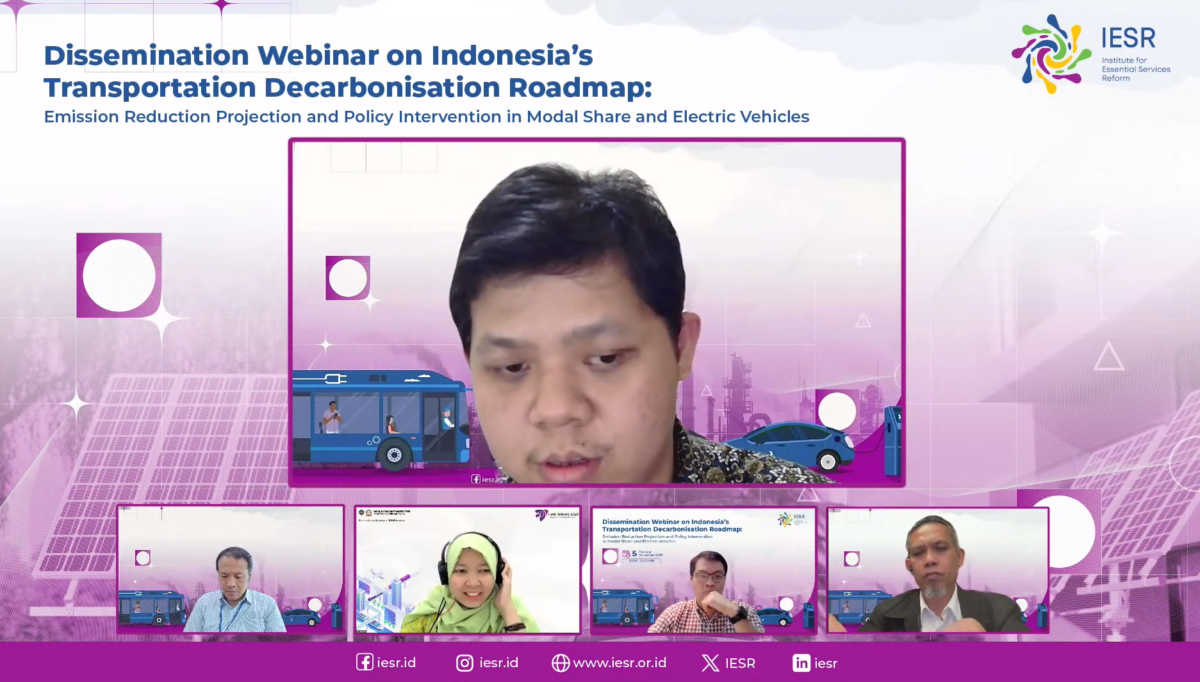Jakarta, 5 December 2023 – Since 2021 the transportation sector in Indonesia has been ranked as the second highest emitter, displacing industry. Many emissions from the transportation sector are caused by burning fuel, which is the main energy source for vehicles. With projected economic growth and development plans, it is predicted that emissions from the Indonesia’s transportation sector will continue to increase. As an effort to strengthen climate change mitigation actions, decarbonization of the transportation sector is important.
Fabby Tumiwa, Executive Director of the Institute for Essential Services Reform (IESR) in the webinar entitled “Dissemination of Indonesia’s Transportation Decarbonization Roadmap”, (5/12) emphasized that to ensure each climate change mitigation actions are in line with the Paris Agreement, emission reduction targets must be calculated not just based on percentages but also taking into account alignment with Paris targets.
“IESR carries out modeling to find policies and steps that can be taken to increase Indonesia’s climate change mitigation actions, especially in the transportation sector,” said Fabby.
The draft transportation decarbonization roadmap focuses on two scales, namely the national and regional scales (Jabodetabek).
IESR sustainable mobility analyst, Rahmi Puspita Sari added that the increase in private vehicle ownership, especially motorbikes, has been one of the factors causing increased emissions from the transportation sector.
“With various types of demand growth and the choice of mode still being private transport, this has an impact on greenhouse gas (GHG) emissions in the transportation sector. “Most of the GHG emissions come from passenger transportation (73%), and followed by land transportation (27%),” said Rahmi.
Fauzan Ahmad, member of the Tasrif Modeling Team, who participated in modeling the transportation decarbonization road map, explained one of the main findings from this simulation, namely that in the Avoid, Shift, Improve (ASI) scheme, which is quite common for transportation management, there is potential for reducing emissions up to 18% by avoiding travel by implementing a work from home (WFH) system.
“Actually, only 8% of the total workers can work from home, of this 8% potential, currently only around 1% of workers work from home. If this potential is maximized, we can reduce emissions even more by the number of trips avoided,” said Fauzan.
Fauzan also added that the choice to review transportation patterns in Jabodetabek was because Jabodetabek was considered as a unified area that interacts with each other.
Arij Ashari Nur Iman, a modeler from the Tasrif Modeling Team, added that with the current condition of the transportation system, the most effective solution for decarbonizing the transportation sector is to divide passenger loads into various modes (mode share).
“Electric vehicles will have a big impact on the goal of reducing emissions, but two conditions must be achieved to have an impact on a national scale, namely increasing the sales share of electric vehicles and creating a policy framework that supports the discard rate of ICE vehicles. Modal shifting to public transportation will be a sustainable solution in the context of fuel and resource use, but requires large initial investment,” explained Arij.
Professor of civil engineering at Gadjah Mada University (UGM), Agus Taufik Mulyono, stated that the Indonesian government still does not have the courage to create (transportation) policies that encourage share modes.
“This share mode issue must be regulated by the government in law, currently there is no law. This study is good, because when more advanced modes of sharing are deemed difficult, then both are still road transportation, but shared between spaces,” he said.
Agus also reminded of implementation challenges if the recommendations of this study were adopted in the form of policies or regulations.
In line with Agus, Alloysius Joko Purwanto, Research and Development Commission, Jakarta City Transportation Council also highlighted the use of public transportation which should be further encouraged.
“Current policies have the potential to cause contradictions, such as the electric vehicle incentive policy, which on one hand has the potential to increase private vehicle ownership rates and has the potential to increase traffic jams because the discard rate for ICE vehicles is still low,” said Joko.
The use of biofuels is also included in the transportation decarbonization roadmap modeling. Edi Wibowo, Director of Bioenergy, Ministry of Energy and Mineral Resources, said that the results of this study are broadly in line with Indonesia’s energy transition road map which will generally add renewable energy capacity to power plants and other sectors will also follow to shift to a more efficient system like such as biofuel.
“We (at the Ministry of Energy and Mineral Resources) continue to develop biofuels, currently we are testing the application of Biodiesel B40 and if the process goes smoothly in 2026 it will start to be used. This (development) effort is a form of real support for Indonesia’s energy transition plan,” said Edi.
Gonggomtua E. Sitanggang, Director, ITDP Indonesia emphasized the importance of public communication to raise awareness among the public. When the public has sufficient awareness and knowledge about the importance of a low-emission transportation system, it will be easier to involve and mobilize them to slowly reduce their dependence on the use of private vehicles.
“Apart from that, it is also important to look at the relationship between the national government and regional governments. What needs to be underlined is our laws and regulations relating to regional autonomy (otonomi daerah), where the one who has the budget and authority is the regional government, while transportation has not yet become one of the KPIs (key performance indicators) for regional leaders. As a result, the budget for the transportation sector is very minimal,” said Gonggom.

